Icephobic Coating Based on Epoxy/Polydimethylsiloxane Interpenetrating Polymer Network Gel
Abstract
1. Introduction
2. Materials and Methods
2.1. Materials
2.2. Preparation of the Epoxy/PDMS IPN Gel
3. Characterization and Performance Measurement
4. Results and Discussion
4.1. Icephobic Properties of the Epoxy/PDMS IPN Gel
4.1.1. Surface Chemical Composition and Surface Topography
4.1.2. Wettability
4.1.3. Elastic Modulus of the Epoxy/PDMS IPN Gel
4.2. Durability Test and Coating Adhesion Test
4.2.1. Icing/Deicing Cyclic Test
4.2.2. Deicing Tests at Different Temperatures
4.2.3. X-Cut Coating Adhesion Test
4.2.4. Salt Spray Aging Test
5. Conclusions
- (1)
- The inclusion of silicone oil enhances the icephobic properties of the coating, addressing the previously identified lack of icephobic ability of the epoxy. At a 200% silicone oil content, the ice adhesion strength of the epoxy/PDMS IPN gel (1:1) measured 8.4 ± 3.4 kPa. Notably, there exists a strong linear relationship between τice and E0.5. The roughness and wettability of the coating exhibit a negligible impact on its icephobic properties.
- (2)
- The epoxy/PDMS IPN gel (1:1) showed increased durability during icing/deicing cyclic tests and superior adhesion in X-cut coating adhesion tests. The ice adhesion strength of the epoxy/PDMS IPN gel (1:1) remained stable and below 20.1 kPa at temperatures ranging from −5 to −30 °C. Even after 168 h of the salt spray aging test, the epoxy/PDMS IPN gel (1:1) maintained an effective icephobic ability, with τice at 48.72 ± 5.27 kPa.
Author Contributions
Funding
Institutional Review Board Statement
Informed Consent Statement
Data Availability Statement
Conflicts of Interest
References
- Golovin, K.; Tuteja, A. A Predictive Framework for the Design and Fabrication of Icephobic Polymers. Sci. Adv. 2017, 3, e1701617. [Google Scholar] [CrossRef] [PubMed]
- Azimi Dijvejin, Z.; Jain, M.C.; Kozak, R.; Zarifi, M.H.; Golovin, K. Smart Low Interfacial Toughness Coatings for On-Demand de-Icing without Melting. Nat. Commun. 2022, 13, 5119. [Google Scholar] [CrossRef] [PubMed]
- Esmeryan, K.D. From Extremely Water-Repellent Coatings to Passive Icing Protection-Principles, Limitations and Innovative Application Aspects. Coatings 2020, 10, 66. [Google Scholar] [CrossRef]
- Zhu, Z.; Tian, Y.; Liu, Y.; Fu, K.; Chen, Q.; Zhang, B.; Zhang, H.; Zhang, Q. Facile Synthesis of Superhydrophobic Coating with Icing Delay Ability by the Self-Assembly of PVDF Clusters. Colloids Surf. A Physicochem. Eng. Asp. 2022, 641, 128562. [Google Scholar] [CrossRef]
- Jian, Y.; Gao, H.; Yan, Y. Fabrication of a Superhydrophobic Micron-Nanoscale Hierarchical Structured Surface for Delayed Icing and Reduced Frosting. Surf. Interfaces 2022, 34, 102353. [Google Scholar] [CrossRef]
- Zheng, Q.; Lv, J.; Zhang, J.; Feng, J. Fabrication and Application of Icephobic Silicone Coatings on Epoxy Substrate. Prog. Org. Coat. 2021, 161, 106483. [Google Scholar] [CrossRef]
- Li, B.; Xiang, H.; Dai, X.; Zhu, T.; Hua, X.; Yuan, Y. A Superhydrophobic Anti-Icing Surface with a Honeycomb Nanopore Structure. Coatings 2023, 13, 1971. [Google Scholar] [CrossRef]
- Yu, B.; Sun, Z.; Liu, Y.; Zhang, Z.; Wu, Y.; Zhou, F. Improving Anti-Icing and De-Icing Performances via Thermal-Regulation with Macroporous Xerogel. ACS Appl. Mater. Interfaces 2021, 13, 37609–37616. [Google Scholar] [CrossRef]
- Golovin, K.; Kobaku, S.P.R.; Lee, D.H.; DiLoreto, E.T.; Mabry, J.M.; Tuteja, A. Designing Durable Icephobic Surfaces. Sci. Adv. 2016, 2, e1501496. [Google Scholar] [CrossRef]
- Kim, J.H.; Kim, M.J.; Lee, B.; Chun, J.M.; Patil, V.; Kim, Y.-S. Durable Ice-Lubricating Surfaces Based on Polydimethylsiloxane Embedded Silicone Oil Infused Silica Aerogel. Appl. Surf. Sci. 2020, 512, 145728. [Google Scholar] [CrossRef]
- Huang, X.; Tepylo, N.; Pommier-Budinger, V.; Budinger, M.; Bonaccurso, E.; Villedieu, P.; Bennani, L. A Survey of Icephobic Coatings and Their Potential Use in a Hybrid Coating/Active Ice Protection System for Aerospace Applications. Prog. Aerosp. Sci. 2019, 105, 74–97. [Google Scholar] [CrossRef]
- Zarasvand, K.A.; Orchard, D.; Clark, C.; Golovin, K. Effect of Curvature on Durable Ice-Phobic Surfaces Based on Buckling Metallic Plates. Mater. Des. 2022, 220, 110884. [Google Scholar] [CrossRef]
- Chatterjee, R.; Bararnia, H.; Anand, S. A Family of Frost-Resistant and Icephobic Coatings. Adv. Mater. 2022, 34, 2109930. [Google Scholar] [CrossRef] [PubMed]
- Jeon, J.; Jang, H.; Chang, J.; Lee, K.-S.; Kim, D.R. Fabrication of Micro-Patterned Aluminum Surfaces for Low Ice Adhesion Strength. Appl. Surf. Sci. 2018, 440, 643–650. [Google Scholar] [CrossRef]
- Hao, T.; Zhang, X.; Lei, Y.; Guo, H.; Zhang, J. Spontaneous Peeling of Ice Accretion: A Novel Expansion Force de-Icing Unit Based on Phase Transition Time Lag. Cold Reg. Sci. Technol. 2023, 208, 103801. [Google Scholar] [CrossRef]
- Sethi, S.K.; Manik, G. A Combined Theoretical and Experimental Investigation on the Wettability of MWCNT Filled PVAc-g-PDMS Easy-Clean Coating. Prog. Org. Coat. 2021, 151, 106092. [Google Scholar] [CrossRef]
- Zhuo, Y.; Xiao, S.; Amirfazli, A.; He, J.; Zhang, Z. Polysiloxane as Icephobic Materials—The Past, Present and the Future. Chem. Eng. J. 2021, 405, 127088. [Google Scholar] [CrossRef]
- Liu, Y.; Zhao, Z.; Shao, Y.; Wang, Y.; Liu, B. Preparation of a Superhydrophobic Coating Based on Polysiloxane Modified SiO2 and Study on Its Anti-Icing Performance. Surf. Coat. Technol. 2022, 437, 128359. [Google Scholar] [CrossRef]
- Wang, X.; Huang, X.; Hu, W.; Ji, Z.; Sheng, H.; Liu, H. Fluorine-Free, Highly Transparent, Chemically Durable and Low Ice Adhesion Icephobic Coatings from Biobased Epoxy and Polydimethylsiloxane. J. Appl. Polym. Sci. 2023, 140, e53456. [Google Scholar] [CrossRef]
- Qi, H.; Lei, X.; Gu, J.; Zhang, Y.; Gu, X.; Zhao, G.; Yu, J. Low Modulus of Polydimethylsiloxane Organogel Coatings Induced Low Ice Adhesion. Prog. Org. Coat. 2023, 177, 107435. [Google Scholar] [CrossRef]
- Ziętkowska, K.; Kozera, R.; Przybyszewski, B.; Boczkowska, A.; Sztorch, B.; Pakuła, D.; Marciniec, B.; Przekop, R.E. Hydro- and Icephobic Properties and Durability of Epoxy Gelcoat Modified with Double-Functionalized Polysiloxanes. Materials 2023, 16, 875. [Google Scholar] [CrossRef] [PubMed]
- Nosonovsky, M.; Hejazi, V. Why Superhydrophobic Surfaces Are Not Always Icephobic. ACS Nano 2012, 6, 8488–8491. [Google Scholar] [CrossRef] [PubMed]
- He, Z.; Xiao, S.; Gao, H.; He, J.; Zhang, Z. Multiscale Crack Initiator Promoted Super-Low Ice Adhesion Surfaces. Soft Matter 2017, 13, 6562–6568. [Google Scholar] [CrossRef] [PubMed]
- Jiang, X.; Lin, Y.; Xuan, X.; Zhuo, Y.; Wu, J.; He, J.; Du, X.; Zhang, Z.; Li, T. Stiffening Surface Lowers Ice Adhesion Strength by Stress Concentration Sites. Colloids Surf. A Physicochem. Eng. Asp. 2023, 666, 131334. [Google Scholar] [CrossRef]
- Chaudhury, M.K.; Kim, K.H. Shear-Induced Adhesive Failure of a Rigid Slabin Contact with a Thin Confined Film. Eur. Phys. J. E 2007, 23, 175–183. [Google Scholar] [CrossRef] [PubMed]
- Li, T.; Zhuo, Y.; Håkonsen, V.; He, J.; Zhang, Z. Durable Low Ice Adhesion Foams Modulated by Submicrometer Pores. Ind. Eng. Chem. Res. 2019, 58, 17776–17783. [Google Scholar] [CrossRef]
- Ronneberg, S.; He, J.; Zhang, Z. The Need for Standards in Low Ice Adhesion Surface Research: A Critical Review. J. Adhes. Sci. Technol. 2020, 34, 319–347. [Google Scholar] [CrossRef]
- Zheng, S.; Bellido-Aguilar, D.A.; Wu, X.; Zhan, X.; Huang, Y.; Zeng, X.; Zhang, Q.; Chen, Z. Durable Waterborne Hydrophobic Bio-Epoxy Coating with Improved Anti-Icing and Self-Cleaning Performance. ACS Sustain. Chem. Eng. 2019, 7, 641–649. [Google Scholar] [CrossRef]
- ISO 25178; Geometrical Product Specifications (GPS)—Surface Texture: Areal. ISO: Geneva, Switzerland, 2017.
- ASTM D3359; Standard Test Methods for Rating Adhesion by Tape Test. ASTM: West Conshohocken, PA, USA, 2017.
- ASTM B117; Salt Spray Fog Testing. ASTM: West Conshohocken, PA, USA, 2019.
- Zhuo, Y.; Håkonsen, V.; Liu, S.; Li, T.; Wang, F.; Luo, S.; Xiao, S.; He, J.; Zhang, Z. Ultra-Robust Icephobic Coatings with High Toughness, Strong Substrate Adhesion and Self-Healing Capability. Sci. China Mater. 2023, 66, 2071–2078. [Google Scholar] [CrossRef]
- Bellido-Aguilar, D.A.; Zheng, S.; Huang, Y.; Zeng, X.; Zhang, Q.; Chen, Z. Solvent-Free Synthesis and Hydrophobization of Biobased Epoxy Coatings for Anti-Icing and Anticorrosion Applications. ACS Sustain. Chem. Eng. 2019, 7, 19131–19141. [Google Scholar] [CrossRef]
- Yasmin, A.; Luo, J.J.; Abot, J.L.; Daniel, I.M. Mechanical and Thermal Behavior of Clay/Epoxy Nanocomposites. Compos. Sci. Technol. 2006, 66, 2415–2422. [Google Scholar] [CrossRef]
- Adja, A.A.S.; Sobhani, S.; Momen, G.; Fofana, I.; Carrière, J. Step by Step Progress to Achieve an Icephobic Silicone-epoxy Hybrid Coating: Tailoring Matrix Composition and Additives. J. Appl. Polym. Sci. 2023, 140, e54262. [Google Scholar] [CrossRef]
- He, Z.; Zhuo, Y.; Wang, F.; He, J.; Zhang, Z. Design and Preparation of Icephobic PDMS-Based Coatings by Introducing an Aqueous Lubricating Layer and Macro-Crack Initiators at the Ice-Substrate Interface. Prog. Org. Coat. 2020, 147, 105737. [Google Scholar] [CrossRef]
- Stráský, J.; Preisler, D.; Seiner, H.; Bodnárová, L.; Janovská, M.; Košutová, T.; Harcuba, P.; Šalata, K.; Halmešová, K.; Džugan, J.; et al. Achieving High Strength and Low Elastic Modulus in Interstitial Biomedical Ti–Nb–Zr–O Alloys through Compositional Optimization. Mater. Sci. Eng. A 2022, 839, 142833. [Google Scholar] [CrossRef]
- Ge, C.; Luo, X.; Wang, J.; Duan, J.; Wang, N.; Hou, B. Properties of KH550 and Hydroxyl Silicone Oil Co-modified Epoxy Resin and Its Mg-rich Primer. J. Chin. Soc. Corros. Prot. 2022, 42, 590–596. [Google Scholar]
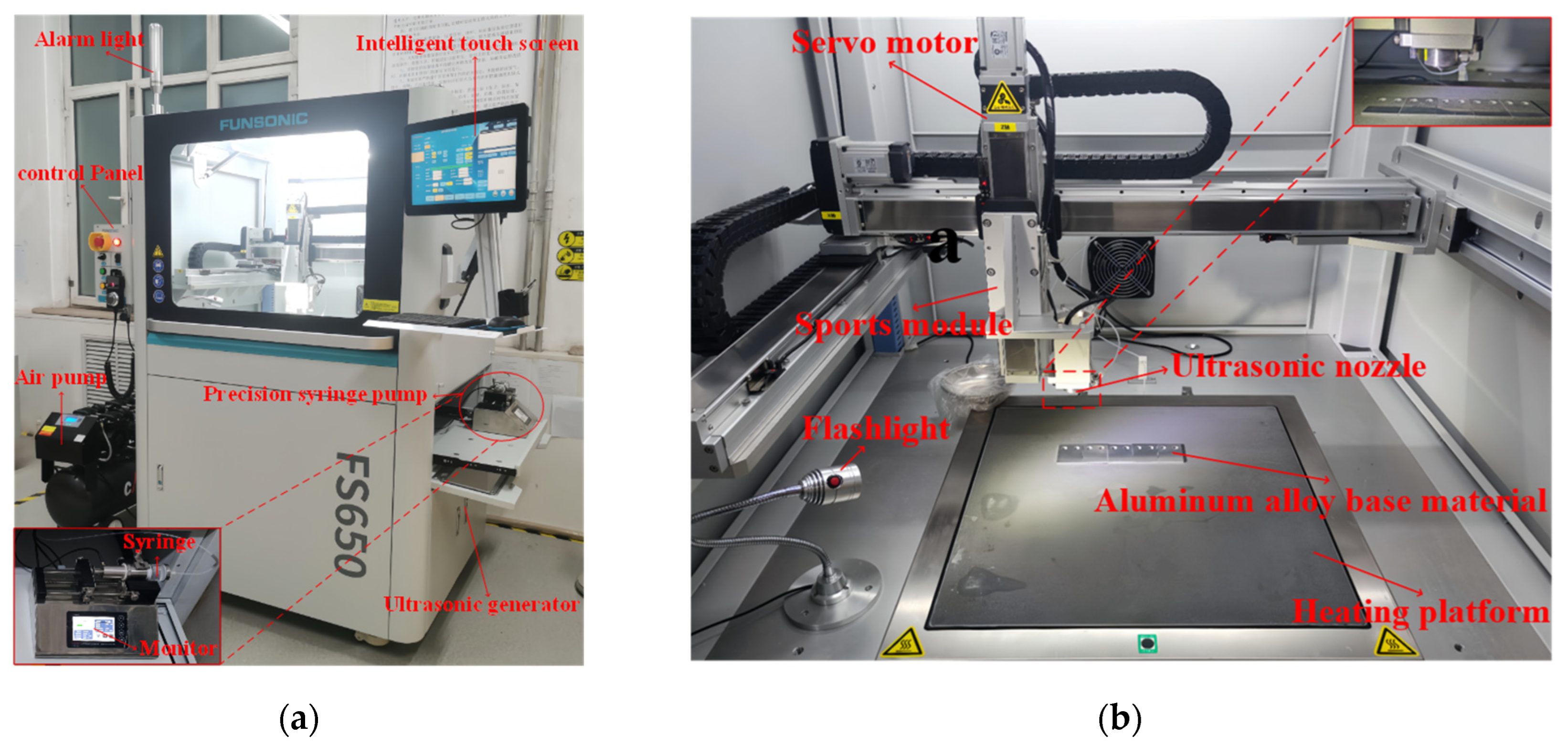

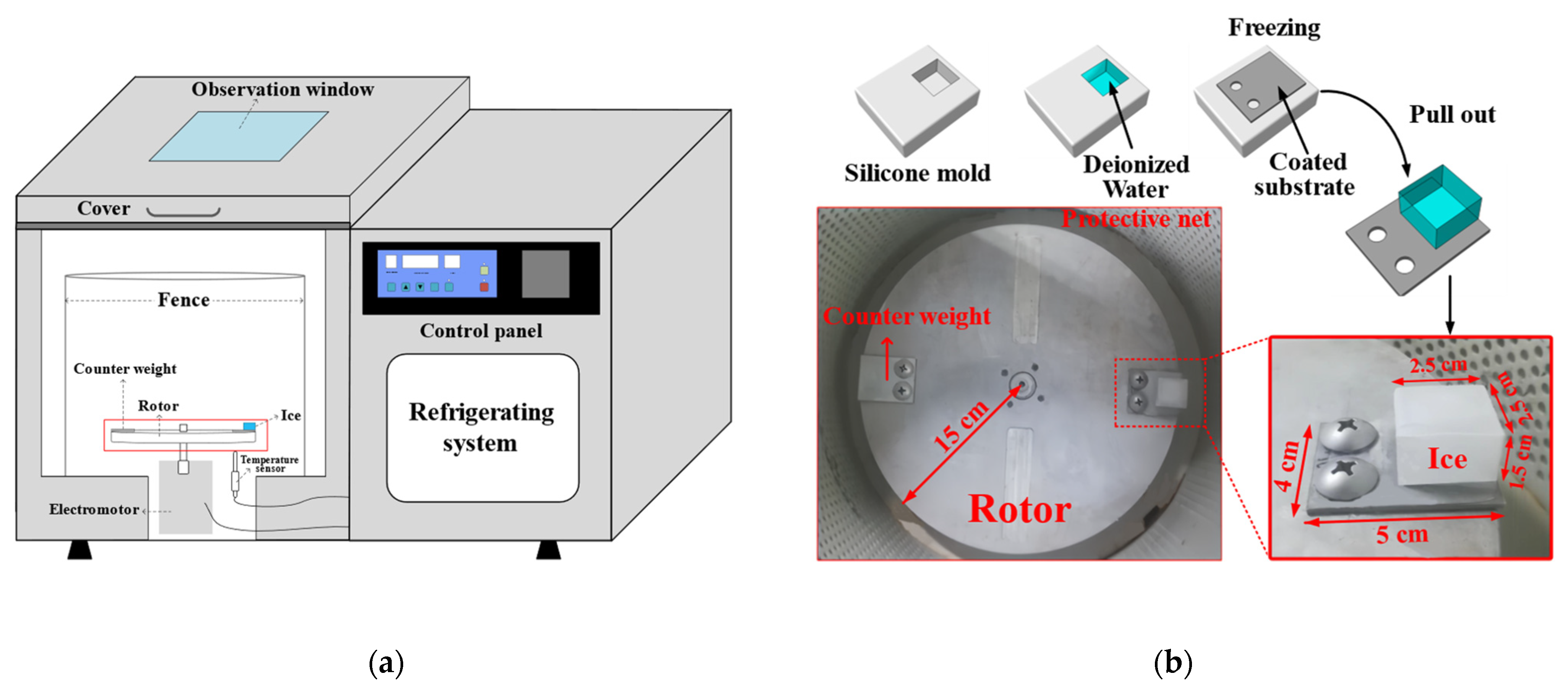
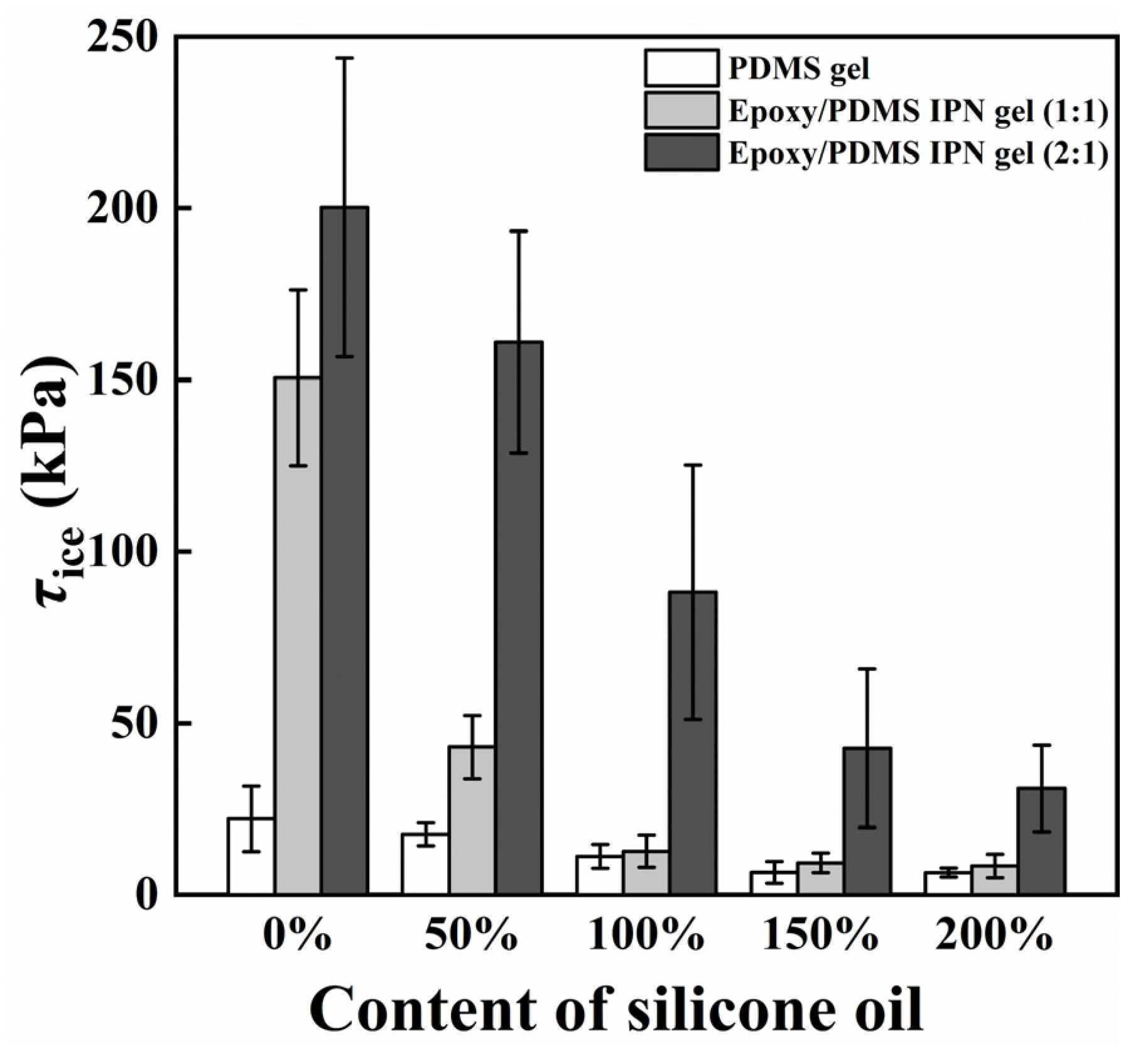
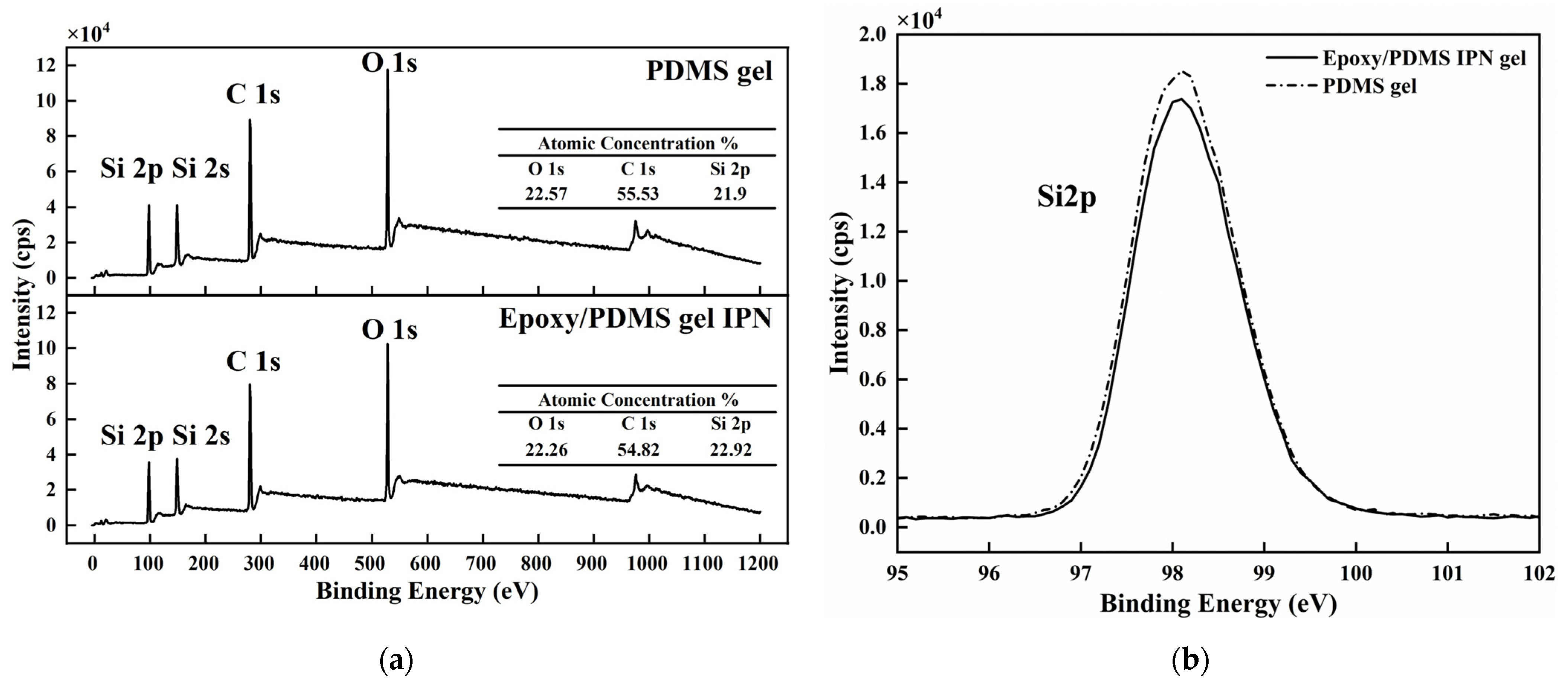
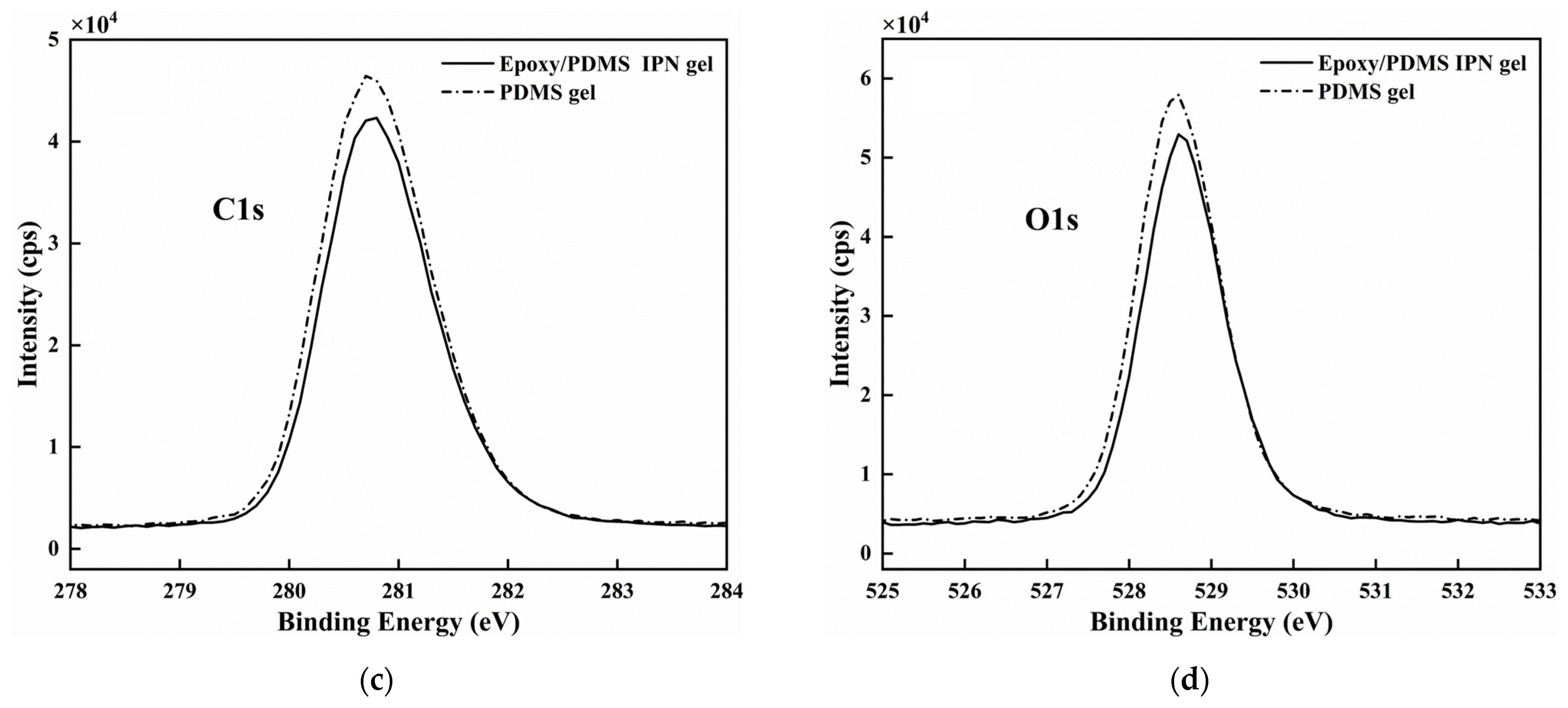
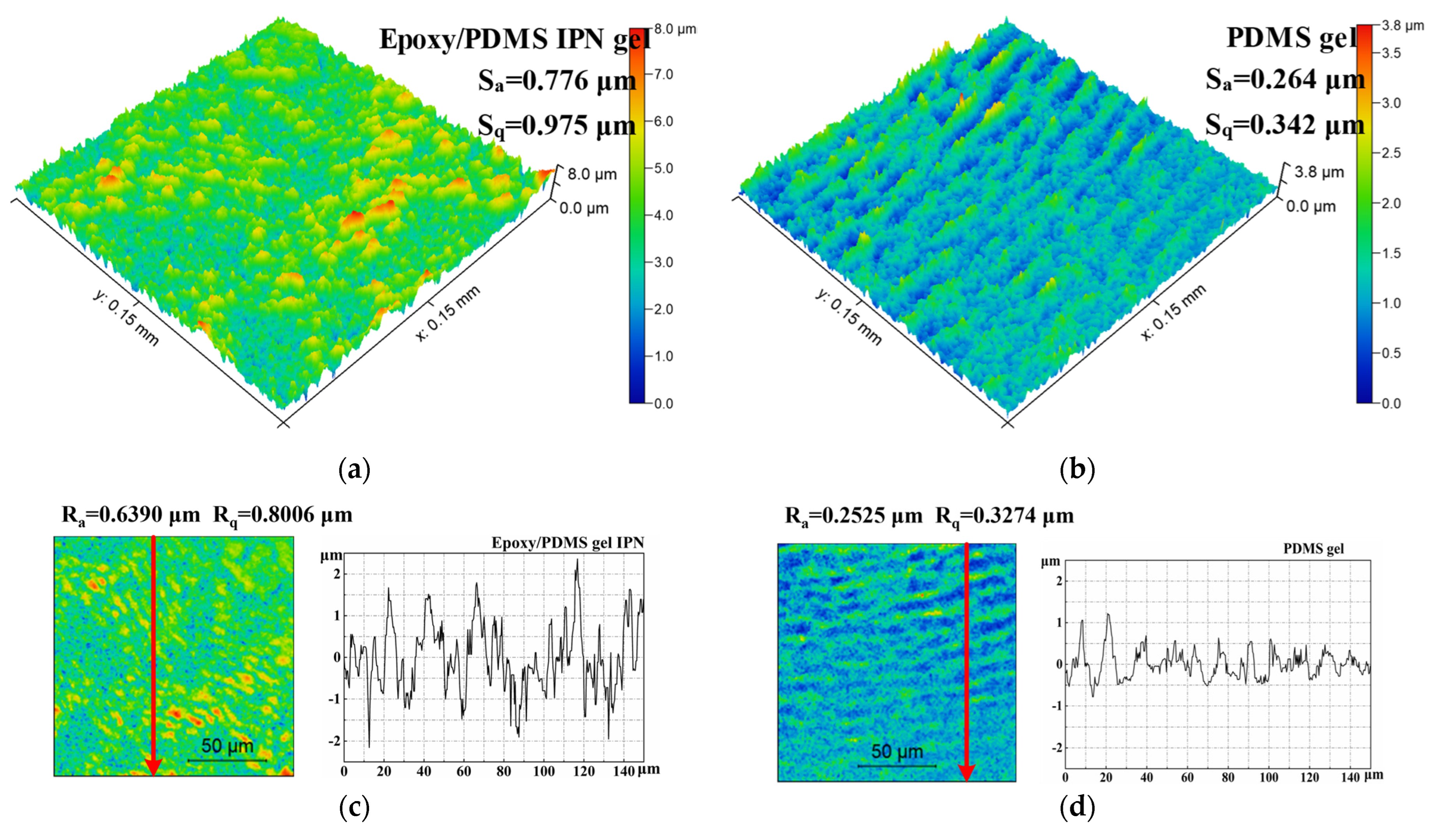
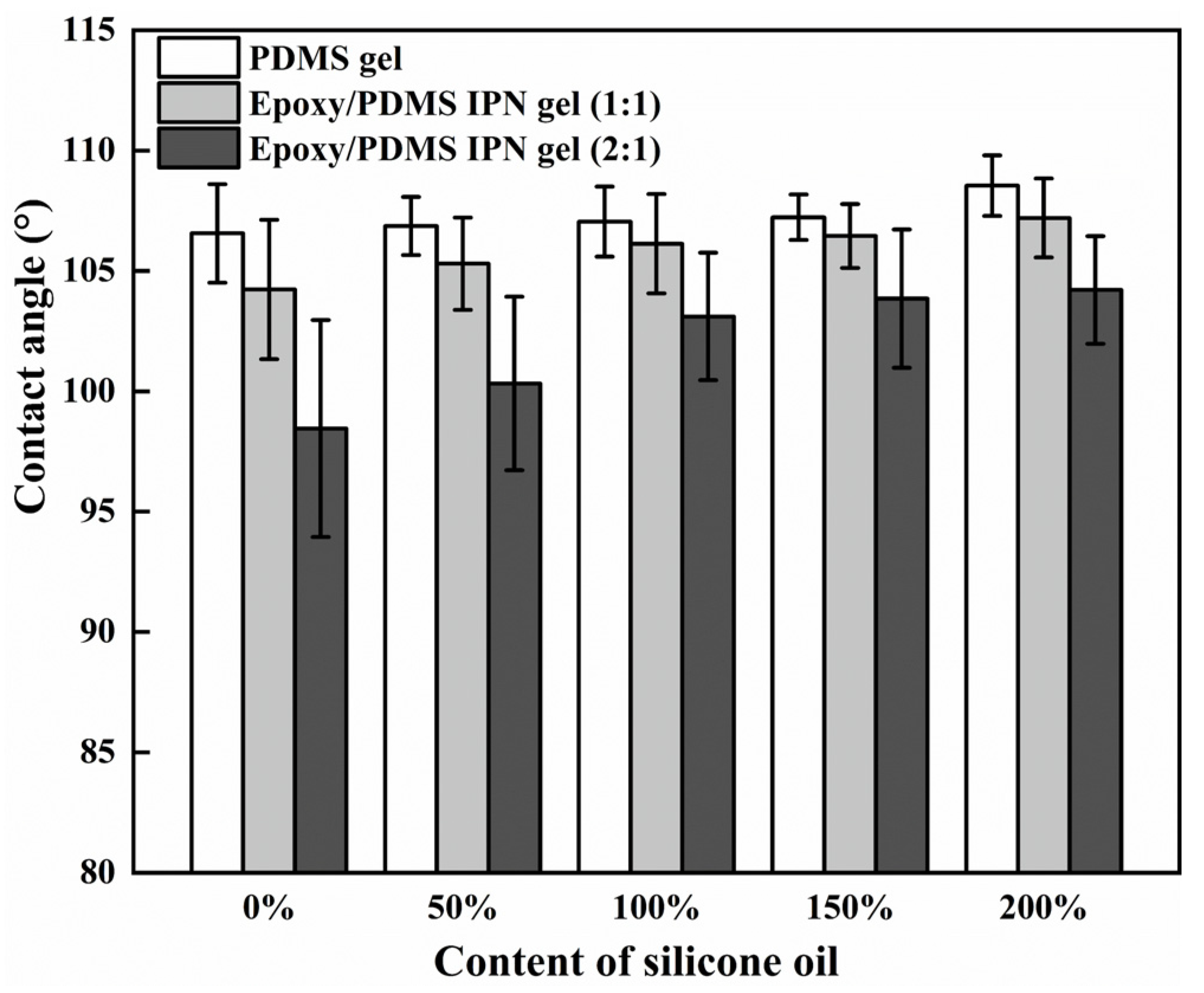
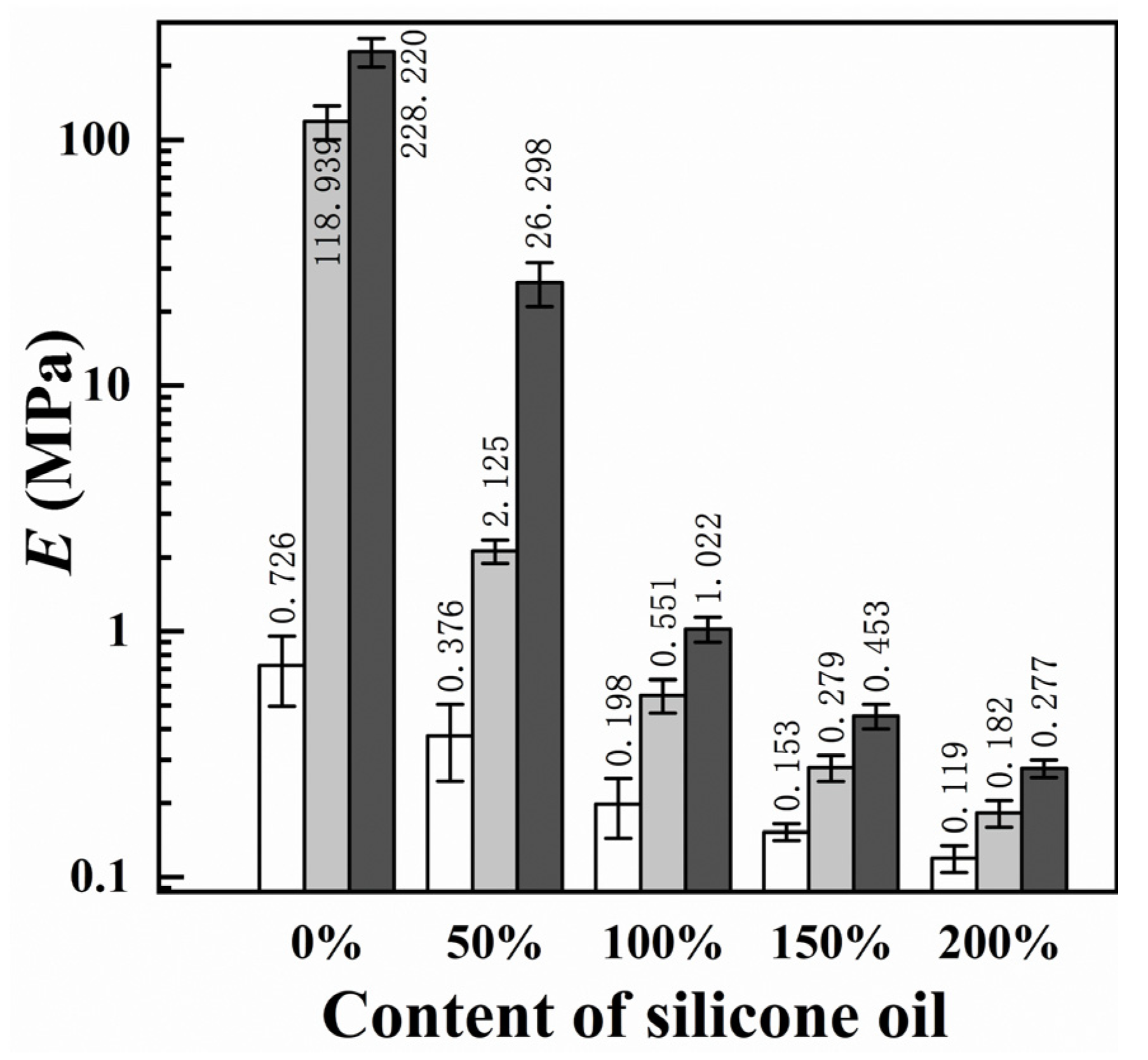
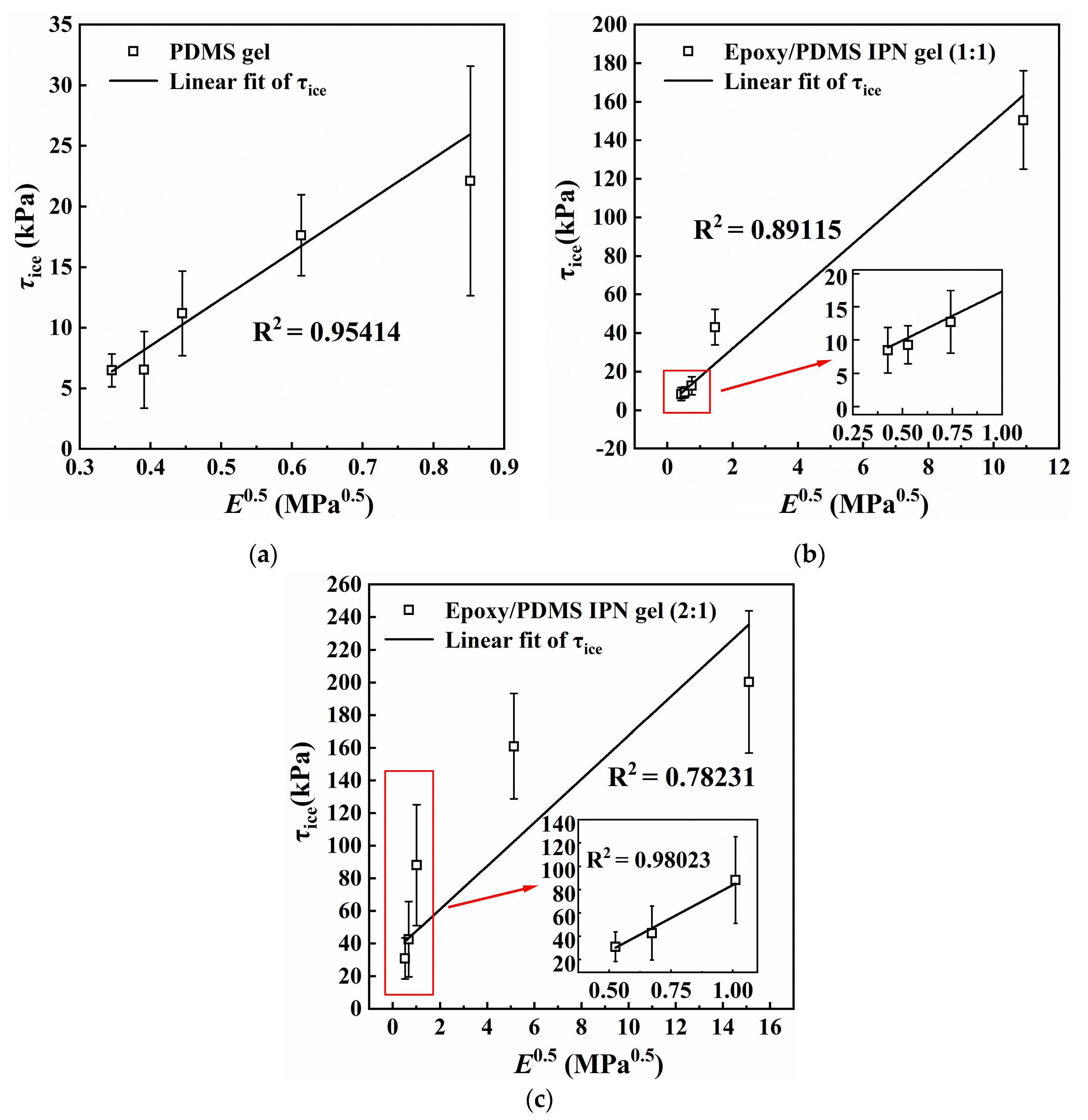
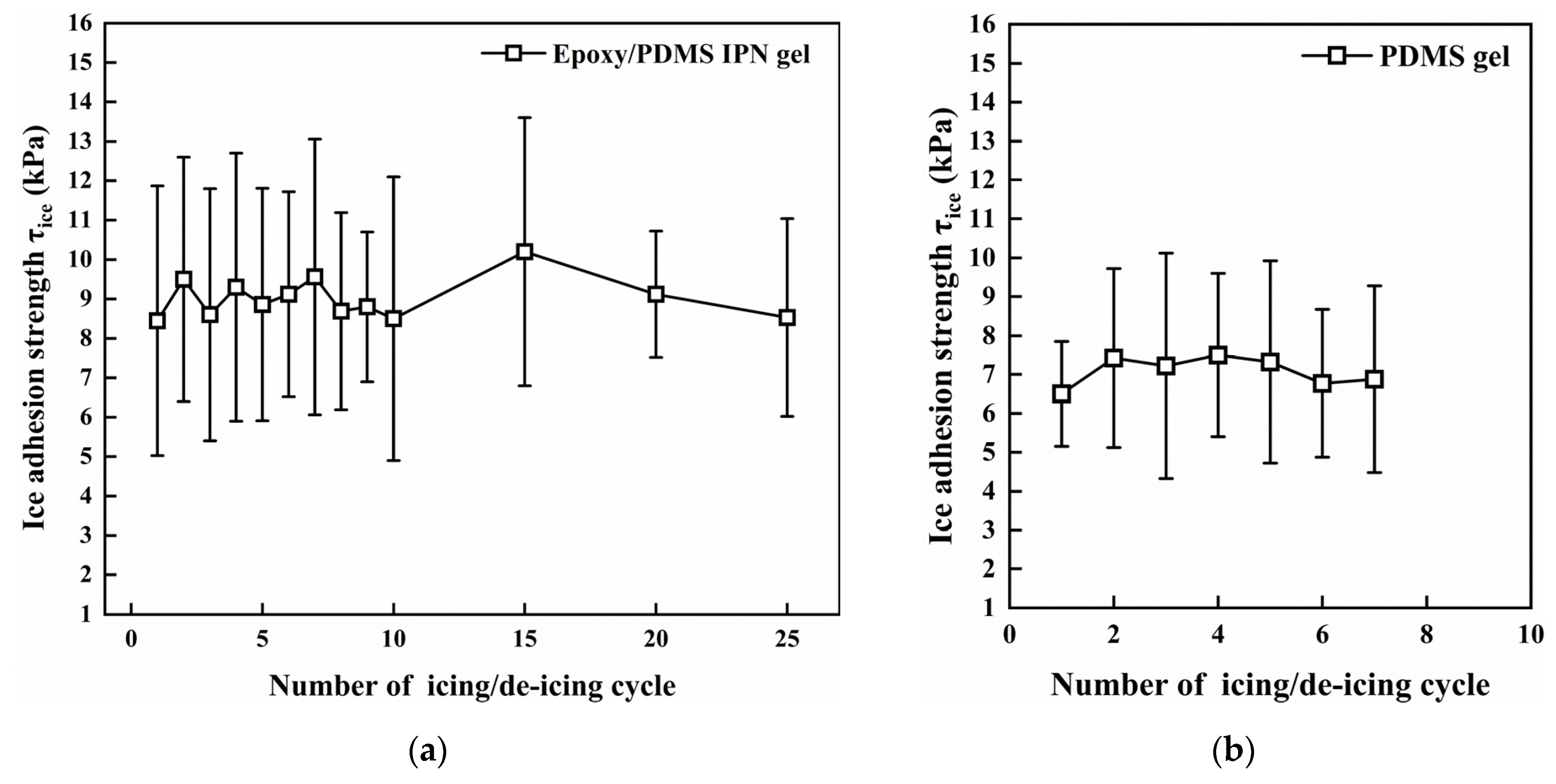
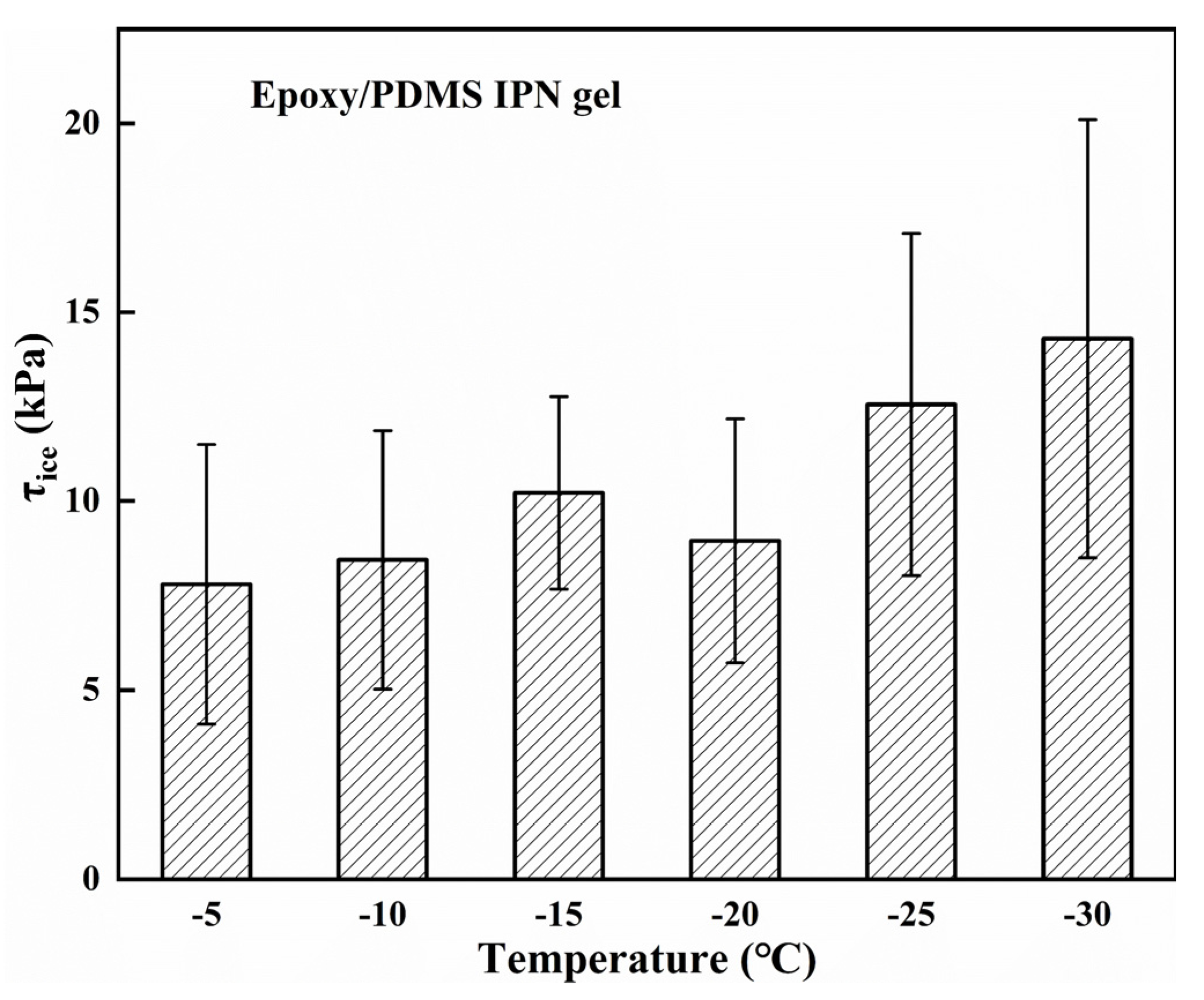
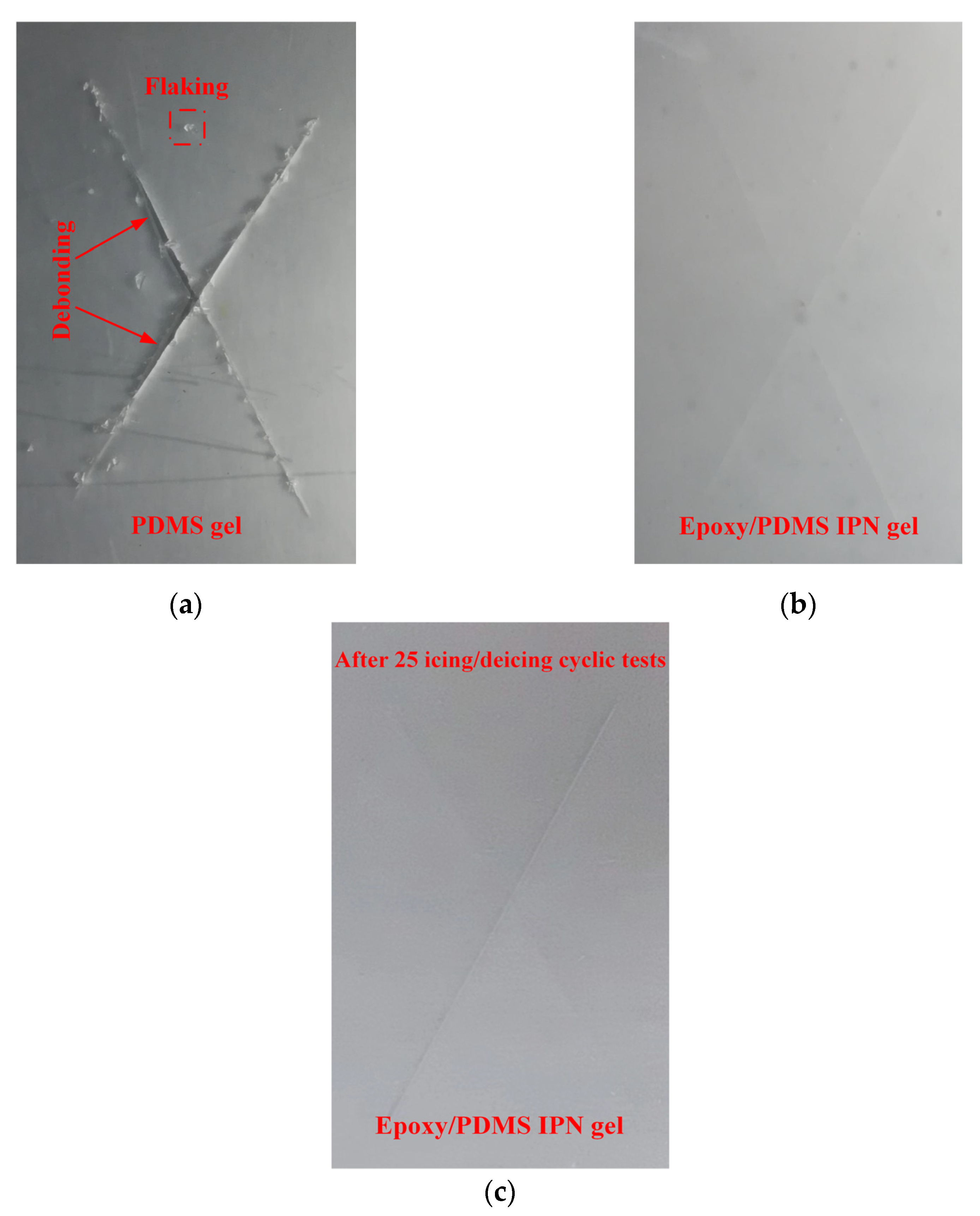

Disclaimer/Publisher’s Note: The statements, opinions and data contained in all publications are solely those of the individual author(s) and contributor(s) and not of MDPI and/or the editor(s). MDPI and/or the editor(s) disclaim responsibility for any injury to people or property resulting from any ideas, methods, instructions or products referred to in the content. |
© 2024 by the authors. Licensee MDPI, Basel, Switzerland. This article is an open access article distributed under the terms and conditions of the Creative Commons Attribution (CC BY) license (https://creativecommons.org/licenses/by/4.0/).
Share and Cite
Zhao, L.; Hao, T.; Xie, Q.; Tian, Y.; Zhang, J.; Guo, H. Icephobic Coating Based on Epoxy/Polydimethylsiloxane Interpenetrating Polymer Network Gel. Coatings 2024, 14, 76. https://doi.org/10.3390/coatings14010076
Zhao L, Hao T, Xie Q, Tian Y, Zhang J, Guo H. Icephobic Coating Based on Epoxy/Polydimethylsiloxane Interpenetrating Polymer Network Gel. Coatings. 2024; 14(1):76. https://doi.org/10.3390/coatings14010076
Chicago/Turabian StyleZhao, Lin, Tianhui Hao, Qiang Xie, Yuan Tian, Jifeng Zhang, and Haotian Guo. 2024. "Icephobic Coating Based on Epoxy/Polydimethylsiloxane Interpenetrating Polymer Network Gel" Coatings 14, no. 1: 76. https://doi.org/10.3390/coatings14010076
APA StyleZhao, L., Hao, T., Xie, Q., Tian, Y., Zhang, J., & Guo, H. (2024). Icephobic Coating Based on Epoxy/Polydimethylsiloxane Interpenetrating Polymer Network Gel. Coatings, 14(1), 76. https://doi.org/10.3390/coatings14010076







